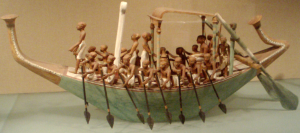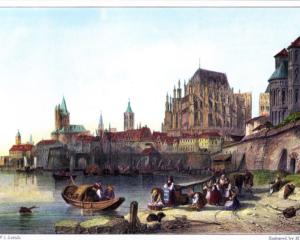By Lanora Osborne
Water ways have been used for centuries as a mode of transportation. Record of water traffic can be found in historical literature such as the Bible or the art of Ancient Egyptians pictured below.

Egyptian Art found in in the Sun temple of Neuserre, Abu Ghurab.
Built during the 5th Dynasty, c. 2465–c. 2325 BCE (Abu Jirab, 2014).Photo by Kairoinfo4u, used under 
When examining European transport during the 18th and 19th it is not possible to see the important changes in water traffic without being aware of its historical existence. According to Angela Murock Hussein in Ancient Egyptian culture, boats were prevalent and used for a wide variety of activities including: work, trade, pleasure, war, and even funerary purposes (Angela Murock Hussein, 2010).

Above is a model of an ancient egyptian vessel that would have been used in the funeral.
by Keith Schengili-Roberts, used under
Compared to 2000 BCE Egypt, water travel was very different in 18th and 19th century Europe. Water vessels continued to be used largely for Commerce. Upon entering the 18th century, using boats in this manor began to face major problems throughout Europe. In order to solve these problems, revolutionary legislature was developed for water transportation.
The major problems facing water transport in the 18th century was what came from fragmented authority along the water routes (Spaulding, 2011). This problem existed primarily in rivers such as the Rhine. These rivers were used for transportation of goods within Europe. Rivers such as the Rhine crossed several different nations, states, and cities and as a result, they lacked coordinated regulation which led to chaotic conditions and noticeable underuse (Spaulding, 2011). In the 19th century revolutionary legislature began to form, making the Rhine River, one of the world’s busiest rivers, as well as a a leader in this revolution.

This painting shows the view of a small port along the Rhine river in the mid 19th Century.
by Cornelis Springer, used under 
According to Spaulding in 1789 the Rhine River consisted of, “Dilapidated infrastructure, physical impediments, tolls, city monopolies, and the privileges of the boatmen’s corporations [which] combined to make river commerce unpredictable and expensive, eroding a good deal of the advantage that water transportation,” and “By the eighteenth century, water transport on the Rhine had lost a good deal of its commercial competitiveness” (Spaulding, 2011). The transportation legislative revolution on the Rhine River began when French military success gained the nation a large portion of the river (Spaulding, 2011). This victory was governed by the Hague Treaty, the treaty declared that neither France nor the Netherlands could prohibit friendly commerce along the river (Spaulding, 2011). French rulers pronounced the river free, creating continued military success granted the French larger portions of the river meaning longer stretches of free river (Spaulding, 2011).

This is a painting of a port along the Rhine River in the city of Cologne during the mid 19th Century.
by William Leighton Leitch, used under 
The French government then worked with Germany to negotiate terms that would improve the commercial practices along the river (Spaulding, 2011). In these negotiations the French urged Germany to eliminate tolls along the river. In February 1805 the “Octroivertrag” was ratified (Spaulding, 2011). According to Spaulding this agreement, “dramatically reformed the previously anarchic Rhine tolls and established a truly innovative joint Franco-Imperial administration covering the river from Switzerland to the Dutch border (Spaulding, 2011). ” This agreement drastically reduced the cost and hassle of commerce along this river, and it has been suggested that agreements such as theses connect the historical locality of economics with the emergence of the national and later global economy (Spaulding, 2011).
